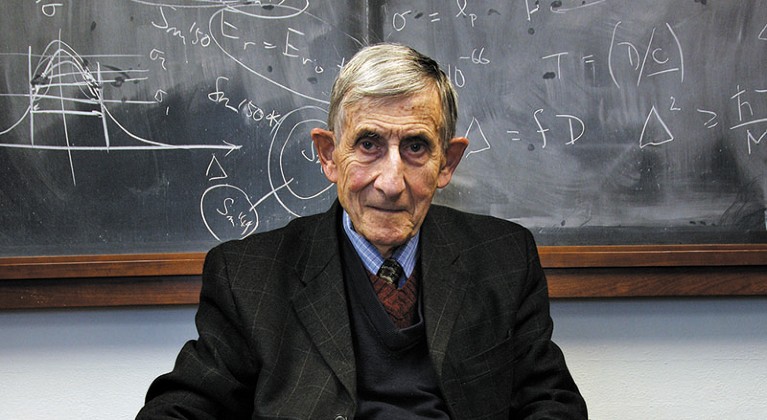
Physicist Freeman Dyson, pictured in 2009.Credit: Eugene Richards
Maker of Patterns: An Autobiography Through Letters Freeman Dyson Liveright: 2018.
Freeman Dyson is a mathematically inclined physicist who proved in 1949 that competing theories of quantum behaviour were equivalent. In a career spanning seven decades, he branched out into myriad fields. They included condensed-matter physics, nuclear reactors, astronomical technology, extraterrestrial habitation and advising the US government on national security, sometimes as part of the elite post-war research group JASON.
Dyson grew up in Winchester, UK, and left in 1941 for the University of Cambridge, where he studied mathematics. There, he began a lifelong habit of writing regular letters home. Now, aged 94 and living in the United States, he has published some of them in Maker of Patterns. They cover a remarkable range of scientific interests, acquaintances, opinions and adventures.
The patterns Dyson says he made were first those of ideas in mathematics and physics, and then those in his writing about literature and history. Readers might hope that Dyson’s own pattern — the reference frame in which his remarkable range becomes a coherent whole — would be found in his letters. As a writer who has interviewed Dyson, I would advise against such hope.
The letters read like a travel journal written for people he loves and trusts. “I think the reason I write so openly is just this,” he tells his parents in 1949, “that all these adventures in this strange new world are still somewhat unreal to me, and in writing to you about them, I bring them in contact with my familiar world and lend them some of your reality.”
Dyson notices everything. He describes Americans’ friendliness as a result of their inattention to the past, and thus of their loneliness in time. He watches astronomers react to an unexpected discovery: how they were impressed into silence and how the theorists mumbled but could say nothing coherent. He quotes and describes children, his own and other people’s: “the children have come out of doors in summer clothes ... [The] grass is green and the crocuses are out. The children are more brightly coloured than the crocuses.”
He describes his “extraordinary collection of friends”. At Cambridge’s Trinity College, he writes, he could always find its splendid mathematicians — including G. H. Hardy — at the local billiard table. At Cornell University in Ithaca, New York, he worked with physicists Hans Bethe (“he says he would have been willing to use atomic bombs to defeat Germany, so convinced was he of the evil character of the government”) and Richard Feynman (“sizzling with new ideas, most of which are more spectacular than helpful”). At the Institute for Advanced Study in Princeton, New Jersey, he had a complex friendship with atom-bomb pioneer J. Robert Oppenheimer (“he is moving around nervously all the time, never stops smoking, and I believe that his impatience is largely beyond his control”).
Some of Dyson’s most vivid descriptions, however, are about encounters and individuals outside science. A theology student at Cambridge “has a deep and resonant bass voice and talks in a slow and rhythmical way, with a solemn ring on the open vowels which is enough to send shivers down one’s spine”. A disabled boat-builder and his girlfriend “walk slowly down the beach … like the last act of King Lear, when the crazy old king and his faithful daughter Cordelia are led away to their doom”.
He says what you wouldn’t expect; if Dyson has a pattern, perhaps it is contrariety. He prefers the students at Haverford College, a liberal-arts university in Pennsylvania — who are “ostentatiously ill-dressed, uncombed, and unwashed” — to Princeton’s “pampered” ones. He contradicts himself. His wartime job at the UK Royal Air Force’s Bomber Command, analysing the effect of Allied firebombing on German cities, left him with a “permanently bad conscience”. Yet he understood the joy of German sailors who torpedoed Allied fuel tankers because he felt “elation” when the firebombing succeeded.
In the late 1950s, he worked with the defence contractor General Atomic in La Jolla, California, on a project he thought would be “legendary”: a spaceship called Orion, ill-advisedly powered by nuclear explosions. Because building it required nuclear testing, he publicly opposed the Nuclear Test Ban Treaty; after Orion was defunded, he supported the treaty. Later, he became president of the anti-nuclear-proliferation Federation of American Scientists. He proposed the ‘no first use’ policy on nuclear weapons, while admiring his theoretical-physicist friend Edward Teller for standing against the treaty. Dyson’s contradictions might seem confusing, but I can hear him politely and methodically explaining the rationality of seeing reality from different reference frames, of holding mutually opposing views and of being free to change one’s mind.
The one Dysonian pattern for which the letters hold unequivocal evidence is delight. He uses the word often and invokes it even more: “Today I discovered a little theorem which gave me some intense moments of pleasure. It is beautiful and fell into my hand like a jewel from the sky.” In the book’s last letter, he writes to his sister about being robbed and hit on the head. Preparing to die, he notices the sunlight on the bushes and thinks, “life has been good to me and this death is also good, with the bright sun and the green bushes”.
Maybe with some people, you don’t look for patterns. You just enjoy their multivariate company.

 Rebel without a pause
Rebel without a pause
 Science's secret service
Science's secret service







